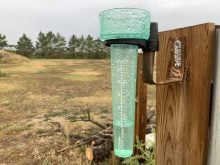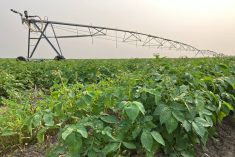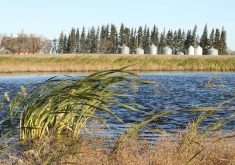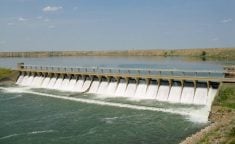If you were to tell the story of the 2022 growing season in Alberta, it would be impossible not to mention that rainfall.
“The story of the year is June rainfall,” said Stuart Chutter, senior analyst with the Agriculture Financial Services Corporation.
[RELATED] Rain sprouts hope among southern Alberta farmers
Read Also

Moo translator and methane measures: There’s an app for that
Dalhousie University researchers use artificial intelligence to create new dairy farm apps that analyze cattle sounds and measure methane.
The growing season started out cold and extremely dry.
“In May, soil moisture was very low across the province, coming out of the 2021 drought,” Chutter noted. “The spring soil moisture just wasn’t there to get things started. Then it just poured in June, and a significant portion of the growing season’s moisture requirements fell across the province.”
Warren Sekulic, who farms with his family in Rycroft, can attest to that.
“The rain came in mid-June. It was a couple good dumps of rain that flooded up pretty good,” said Sekulic, who grows wheat, canola, peas and oats.

“The rain stopped after the big dump in June and we didn’t get another drop of rain, except a little bit in July. The taps turned off after the spring and stayed off.”
Kevin Auch, who farms in southern Alberta, near Carmangay, has a similar story.
“2021 was one of the driest years we’ve had since I started farming (in the 1980s),” said Auch, who has a five-year rotation of peas, canola, cereals and flax, with about 20 per cent of his land under irrigation.
“It was dry right up until our first rain of 2022, which was on June 4. June was fairly wet. Then it kind of stopped and we were dry again right until harvest.”
Much of the bone-dry ground was replenished by the “fantastic recharge” from the June rains, said Chutter.
“That’s what really delivered on above-average yields and quality, and some great harvest conditions to get harvest done,” he said. “There are still some areas of challenge but overall, the Alberta crop was above average for both yield and quality.”
[RELATED] Optimism has returned with the rains for the cattle sector
Prior to last year’s drought, there had been several wet and delayed harvests, but the theme for 2022 was ‘go, go, go.’ In a two-week period (Sept. 6-20), a stunning 40 per cent of the province’s crop was harvested, including 45 per cent of the canola crop and 49 per cent of spring wheat.
But the flip side is that the province will need good snowfall and spring runoff to recharge the dry ground.
“Any soil mapping from September to October, in the last few crop reports, does show us back to very similar dry surface soil and subsurface soil level moisture levels for a large portion of the province, with maybe the exception of the Peace,” Chutter said.
The June rains also made the heat more manageable.
“With the good moisture in June, the heat became something that helped crops in some situations develop and mature, especially after a slow spring start,” he said.
“Relative to historical norms, everything was behind and delayed, whereas after those June rains and the summer heat, crop growth was not just maintaining its delay and catching up, but at the end of the growing season, was at similar to normal growth and development stages.
“That June rain and summer heat seemed to be a productive combination this year.”
Sekulic said the weather at his place was “relentlessly beautiful, with temperatures between 25 C and 31 C.”
“The crops didn’t do all that bad, all things considered,” he said. “The heat came at the last moment and saved stuff that looked like it was going to drown. We came up with some fairly solid average yields.”
Again, that was typical of what many farms saw.
[RELATED] Rains were welcome but bring increased threat of crop diseases
Overall, dryland yields of the major crops were 10 per cent above the five-year average and six per cent above the 10-year average, with the south seeing yields 18 per cent above the five-year average and the Peace 12 per cent higher.
Quality was also fairly high, although that was more variable.
“The peas weren’t all that good, but peas don’t do that well if you talk loudly in their presence,” said Sekulic. “Our wheat was a good solid average to above average. Our canola was average to a touch below average. But for the most part, all things considered, we did fairly well.”
It was “a mixed bag” for Auch.
“Anything that got into the ground early did OK because the June rain helped it along quite a bit,” he said. “Anything that needed the June rain to get started, it was good at first and then kind of dried up after.”
Much of the south was in the same boat, he noted.
In fact, while yields in the south were well above the five-year average, they were slightly below the 10-year average. Canola averaged just over 30 bushels an acre in the south, versus 38 to 41 in the rest of the province. Spring wheat, at 41 bushels an acre, seriously lagged other regions that saw yields ranging from 51 bushels an acre in the Peace to 63 in the central region.
But while yield and quality varied, prices thankfully remained strong, he added.
“I’m always optimistic that next year is going to be better,” Auch said. “You don’t have quite as good a yield as you’d like to see, but it’s always good when the prices are good.
“I’m optimistic if we get a bit of moisture and a half decent crop, it looks like we will do OK again (next year).”
















